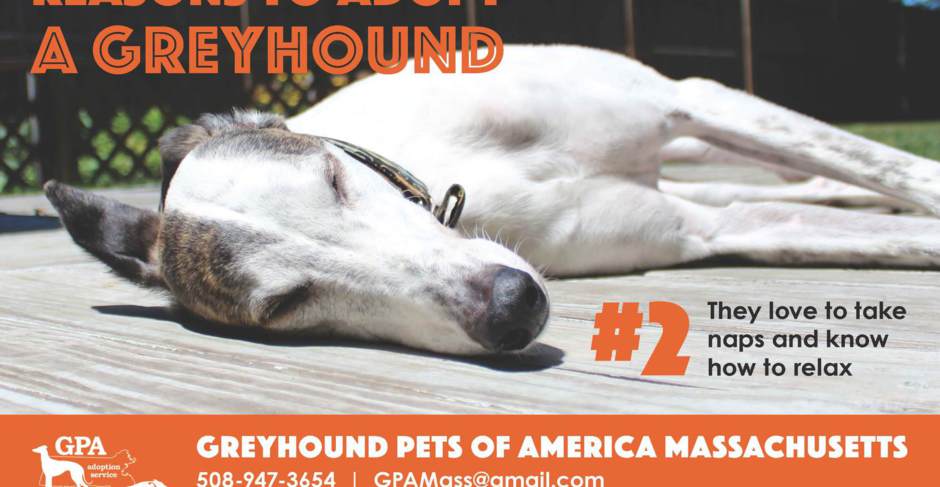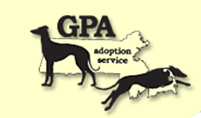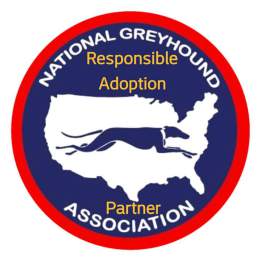What kind of pets do retired racing greyhounds make?
Greyhounds are very affectionate, friendly dogs that thrive on attention and human companionship and make terrific pets once they get used to their new homes. The more love and attention you give the
greyhound, the more you will get back.
What should I expect if I adopt a greyhound?
Because everything is brand new to the newly retired greyhound, expect him to be somewhat confused and very curious. House manners have to be learned but greyhounds are intelligent dogs and learn
quickly. Your tone of voice should be the only correction needed. You may find that your dog is something of a shadow and follows you everywhere. This is part of the greyhound's bonding process. You
are the person the dog has decided to trust first. Be flattered - these dogs seem to pick the humans with whom they want to establish a relationship. To help your dog adjust, take him or her
everywhere you can. They are very curious and sociable dogs and want to know all they can about their new world. The more love and attention you can give your dog, the faster he will adapt to home
life.
Are greyhounds good with children?
Yes, and more so than many breeds. They are not as playful as puppies, of course, being mature dogs, but they are tolerant of children and would usually walk away rather than growl or snap if
children become overbearing. This is not to say, however, that they can be tormented for any length of time and still not growl or snap, since like most dogs greyhounds also have their limits.
How are greyhounds with other pets?
Greyhounds are friendly by nature and socialize well as a result of encounters with other greyhounds in the racing kennel. They can learn to accept cats and small dogs, but the introduction period
must be very closely monitored. The greyhound must be taught to differentiate between the cat or small dog and the mechanical lure he has been chasing around the track.
What is the life expectancy of a greyhound?
Greyhounds have a life expectancy of 12 years or more. This holds true for retired racing dogs as well as others.
What has the life of a racing greyhound been like?
Greyhounds have spent most of their lives in the company of other dogs. When they are born the average litter size is about 8 pups. Young greyhounds are given a lot of attention and handled as much
as possible. As they approach their first birthday their training begins and they are taught how to chase a lure, eventually progressing to a racetrack. Track life is very routine - feeding in the
morning, turnouts in the exercise pen to answer calls of nature, and resting between races in individual kennel crates. Dogs race every 3 to 5 days and most racing kennels have about 60 dogs.
Amazingly, most trainers have a special story about each and every dog with whom they work. So, as you can see, most greyhounds have seen very little of the every day world including houses, stairs,
mirrors, cats etc. and have seldom if ever ridden in anything but a dog truck. Life with a family is like being reborn for a greyhound.
Why is routine important to my greyhound?
Greyhounds are used to having a daily routine in the racing kennel and they tend to feel more comfortable in unfamiliar situations if a routine is established for feeding, calls of nature and
resting. Please note that in a home situation, until the routine is established you will need to take more frequent trips outside to avoid accidents.
Do greyhounds need a lot of exercise?
Your greyhound, like every dog, needs exercise, but they do not require as much exercise as you might imagine. Unless you have a completely fenced-in yard, your dog will need at least one long walk
on a leash plus at least three short walks a day to relieve himself. Greyhounds should be taken to an enclosed grassy area once or twice a week where they can sprint. Greyhounds have been
trained to be sprinters but can be excellent jogging companions after they have been conditioned to run a longer distance.
Are greyhounds housebroken?
Greyhounds are crate trained. This means that he knows not to soil his own crate. By taking your dog out frequently to relieve himself, and by giving him lots of praise when he succeeds, you will
quickly establish the correct place for the dog to do its business. Greyhounds have been on a regular schedule in the kennel, therefore, they have never needed to let anyone know when they need to go
out. Like most dogs they do present certain body signals when they need to go. These signals may be heavy panting, serious sniffing of the floor or restless pacing. Initially expect a few accidents.
It takes a little while for you and your greyhound to learn each other's language and timing. If you catch your dog having an accident, don't punish your dog but let him know from your tone of voice
that this is not acceptable behavior. Hurry your dog outside and encourage him. When he relieves himself outside praise him. Vinegar and water or Nature's Miracle (available in pet stores) is good
for cleaning the area and takes care of the odor. When you take your dog outside to relieve himself, you will notice that he seems to be looking for the "right" spot, which may take some time. Once
found, your dog will relieve himself and the next time you take him outside you should take him to the same area. Calmly wait for your dog to do his business and don't distract him as you want him to
focus on the reason for being outside. Once he has relieved himself then you can walk, play or do other fun things.
Does my dog need a special place in the house?
In the kennel your dog has always had its own kennel crate where it felt safe and secure. There are a number of ways of accomplishing this in your house. Using a large crate or having a special
bedding area during the adjustment period will help the greyhound adjust at his own pace to the unaccustomed freedom of your house. Although many people feel uncomfortable about using a crate,
greyhounds are quite at home in them. Indeed, using a crate can provide for a completely successful transition by affording the dog actual physical security when left alone during the adjustment
period and thus preventing any possible damage due to separation anxiety. It can also eliminate any temptation to investigate the garbage. Another advantage to the crate is that most greyhounds will
not soil their own living space. This makes using a crate a very effective tool in the housebreaking process.
How do I teach my greyhound to do stairs?
If you have stairs, be patient. Place the dog's feet one at a time on the stairs and with your body firmly behind the dog so he or she cannot back down proceed up the stairs one foot at a time giving
lots of encouragement along the way. Going downstairs may require a little more muscle as your dog may want to take all of the stairs in one jump. Hold on to the collar and allow him to only take one
step at a time. In a few days with patience, your dog will soon navigate them on its own.
How do I teach my greyhound to accept cats and other small animals?
If you have a cat or another small animal and your dog even looks sideways at it, jump right in and say NO! It may take a few times but your dog will quickly get the idea about what is appropriate
behavior with regard to small animals. Never leave your greyhound alone with the family cat or other small animal unmuzzled until you are positive they can get along.
What about feeding?
When adopted, most greyhounds are at what is known as "racing weight". Most will reach "pet weight" within a month or two after adoption. Your dog may seem to devour his food at first, but this will
gradually lessen as he realizes you can be depended upon to feed him regularly. Initially feed your dog 2 to 2 ½ cups of high quality dry food mixed with water twice a day (a total of 4-5 cups per
day). Once your dog has gained some weight, cut the amount back to 3 ½ to 4 cups per day. Avoid dog foods that are red in color as this is done with food dyes and can give your greyhound diarrhea.
Your dog may also get diarrhea when his diet is changed from the kennel diet to the home diet. If your dog gets diarrhea give him Kaopectate every hour for 4 hours until the diarrhea has stopped.
Feed 2 cups each of cottage cheese and plain boiled rice until the stool looks solid. Once the stool starts to firm up, gradually substitute kibble for the cottage cheese then the rice. It is
important to recognize that accidents may happen due to diarrhea and he should be treated with patience and care.
When can I trust my greyhound off leash?
You can NEVER trust a greyhound off leash. This is why we recommend exercising your greyhound in a completely fenced in area. They have
no understanding of cars and if allowed off lead would be apt to either stand in the middle of the road watching the car approach or try to outrun it. Greyhounds are sighthounds and are capable of
running short distances at up to 40 miles per hour. Their instinct is to chase and they have been taught to chase. They will chase small animals such as cats and squirrels and when they catch them
the results can be tragic.
What sort of medical care will my greyhound need?
The best medical care is preventive in nature. Your dog will need to be checked periodically for worms and should have an annual heartworm test and should be placed on a heartworm preventative. When
your dog is neutered he will receive all of his vaccinations and you will need to keep these up to date on an annual basis. Be sure that your veterinarian is familiar with the greyhound's special
anesthesia requirements. You will have to keep after your greyhound's teeth by brushing them and make sure a veterinarian scales your dog's teeth if they have a build-up of tartar. Greyhounds are not
plagued by hip dysplasia but may suffer from arthritis due to old racing injuries.
What about flea collars?
Greyhound's livers do not process poisons the same way other dogs do and they are particularly sensitive to the chemicals in flea collars, some greyhounds have died after being exposed to them.
However Bayer makes a Seresto collar for fleas and tick that most greyhounds seem to have no issues with. There are also topical products like Frontline and Advantix but you should work with your vet
to pick the best product for your greyhound.
What if I have other question?
Please contact us at gpamass@gmail.com



